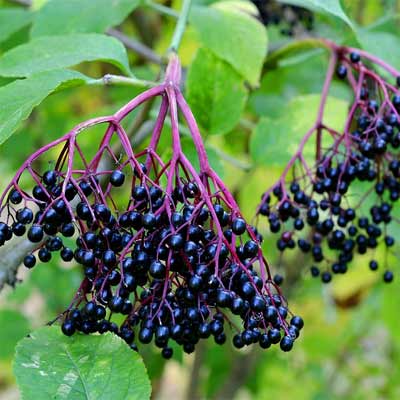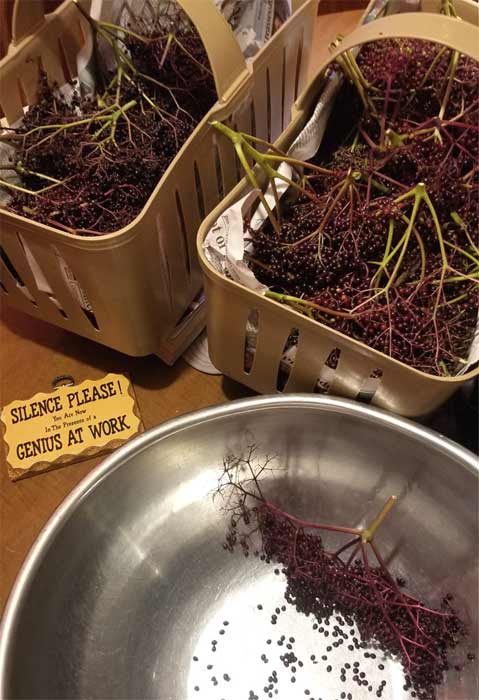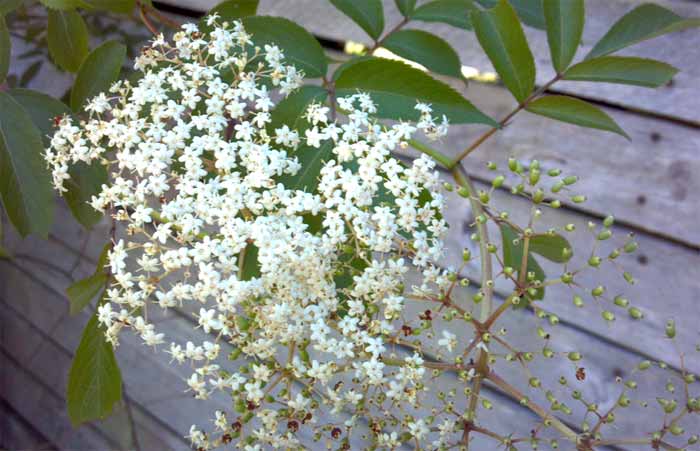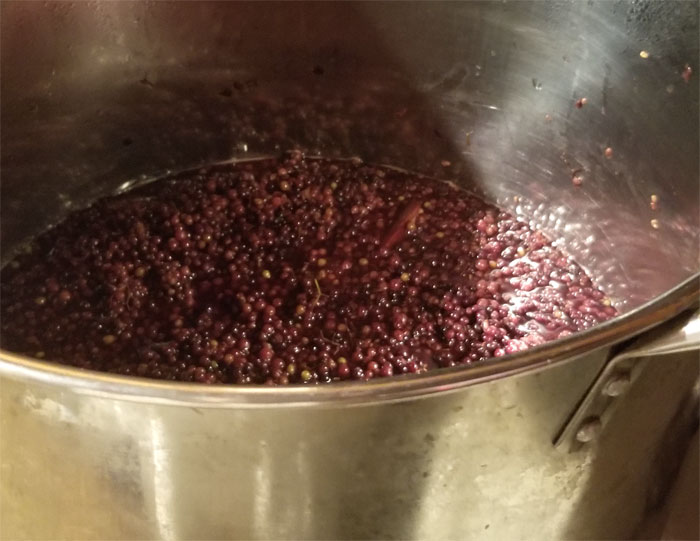Elderberries in herbal medicine

Elderberries are a natural remedy.
Black elderberry (Sambucus canadensis) flowers and berries are used in herbal medicine to treat colds and flu, coughs, constipation, hay fever, mouth ulcers, sore throats, tonsillitis, rheumatism, herpes, wounds, bruises, muscle sprains, and more.
The berries are also used in herbal syrups, jams, teas, and wines.
Elderberry juice is available in most health food stores and makes a delicious, healthy drink especially when mixed with gingerale.
There are several varieties of elderberries.
Sambucus canadensis is also called American elderberry, black elderberry, and Canadian elderberry. It is found growing wild in North and South America, all the way from Canada to Peru. American elderberries like some sun, and will grow in wet or dry soils.
Sambucus nigra is known as black elder, European elder, and European elderberry. It grows wild throughout Europe and southwestern Asia.
Sambucus racemosa is also called red elderberry or red elder. Red elderberries contain considerably more cyanogenic glycosides (which are toxic). Red elderberries are also more bitter than black elderberries, so are not often used in herbal medicine.
Grown in the open, elderberry shrubs will form a small, bushy tree. In the woods, we find elderberry plants vining through the trees reaching for sunlight.
Never eat the stems, bark, or leaves from an elderberry bush! Also, the berries must be processed before eating. Processing the berries by cooking or fermenting them, plus removing the seeds, makes them safe to take internally.
Do not confuse elderberries with polk berries. Elderberries and polk berries are both dark purple when ripe. They also ripen at the same time in late summer. You can tell them apart because their leaf shapes and growth habits are very different.
Making simple and easy elderberry syrup from fresh elderberries:
- Wash berries and remove from stems.
- Cover with water.
- Bring to a simmer and cook gently for about 5 minutes. Do not boil to hard or simmer too long or you will lose many of the healthy properties.
- Cool and strain through a sieve or jelly bag to remove seeds.
- Put juice back into your pot and add sugar or honey. Add more sugar and honey for a thick syrup. Add less for a thin syrup.
- Heat gently until the sugar or honey has dissolved.
- Pour into mason jars and can like any juice in a boiling water bath. You may also keep your juice in the refrigerator for immediate use instead of canning it. It will keep for a month. You can also freeze the juice for up to a year.
Elderberries on Payne Mountain Farms
We love elderberry syrup. During winter months, we take about a tablespoon per day as natural protection against colds and flu. You can take it alone or with juice.
My favorite drink in the world is gingerale and elderberry syrup. I combine about 6 ounces of gingerale to a tablespoon of elderberry syrup. With ice and a twist of lemon or lime, it is even more delicious.
Elderberry syrup is also good with champagne and other alcoholic beverages.

Elderberries are used to treat many different health problems.
Elderberries promote sweating and they are diuretic. They are often used to rid the body of parasites and toxins.
Elderberries are also used as a natural laxative in cases of stubborn constipation. A syrup made from elderberries can really get things moving.
When elderberry syrup is used in the treatment of coughs and colds, combine with thyme for extra strength.
Elderberries are a rich source of vitamin A and C. The berries can be dried for use as a nutritious food.
In days before oranges and other citrus fruits were commonly available, elderberries were made into wines and syrups and taken to prevent scurvy.
Elderberries are also used as a hair dye but I haven't tried that yet.

Scientific studies on elderberry as a herbal remedy
Studies show that elderberries have been used for respiratory health for centuries. Trials using elderberry extract prove that the herb has beneficial effects.
When echinacea was added, results were even better. Together these plants help reduce symptoms in colds and flu. They also reduce the duration of a cold or respiratory infection.
Elderberries have antibacterial, antiviral, antioxidant, anti-diabetic, anti-inflammatory, and immunity building properties. Elderberries contain high levels of flavonoids that fight free radical damage in our cells.
They also contain vitamins, minerals, carotenoids, phytosterols, and polyphenols that work together to protect and heal the body. Elderberries are also good for the cardiovascular system and the brain!
Elderberries and air travel
Once study concludes that elderberry should be used before, during, and after air travel.
312 volunteers took elderberry or placebos before flying and after arrival at their destination. All participants kept a diary, noting any cold symptoms or health issues.
When compared, the group taking elderberry had a significantly lower number of sick days. They also reported much shorter durations of symptoms. This is great news for us all, whether we travel or not.

Elderberry flowers
Elderberry flowers are considered a powerful expectorant for the lungs and make useful additions to cough syrups. They reduce phlegm, stimulate the circulatory system, promote sweating, increase urinary flow, and when applied topically, are anti-inflammatory.
Elder flowers are known to soften the skin and are often added to homemade herbal lotions and creams. They help heal chapped skin and are a good addition to hand lotions.
Elderflower water can whiten skin and may even remove freckles. Elder flowers are sometimes added to ointments for the treatment of bruises, sprains, and chilblains.
Use elder flowers to treat colds and flu.
Elder flowers, like the berries, are a good remedy for feverish colds and flu. They are sometimes taken to strengthen the upper respiratory tract and can help prevent hay fever and allergies if taken early in the year before pollen season arrives.
For added strength, combine with yarrow, peppermint, or St. John’s Wort.
Elder flower power
The Herbal Jedi is one of my favorite herbalists. I love his videos and you will, too.
The following video shows us all about harvesting and using elderberry flowers in herbal medicine.
Elderberry bark is sometimes used in herbal medicine.
The bark can cause vomiting, but if you need a cleansing, other herbs are better choices.
Elder bark is also a liver stimulant. My advise is to stick with the elderberry flowers and berries when practicing herbal medicine. In modern times, I see no reason to take chances with toxic substances.
Elderberry leaves
Elderberry leaves can be used as a poultice for wounds in emergency situations, but should not be taken internally.
When crushed and rubbed on skin, they will keep insects away for up to an hour.
Elder wood is hard and close-grained. It is used for making skewers, toys, and shoemaker’s pegs.
Elderberries grow wild in North America.
Elderberry plants grow wild throughout North America and are abundant in the North Georgia area.
Elders produce large clusters of small white or cream colored flowers in the late spring, and are followed by clusters of small red, bluish or black berries.
The shrubs can live over a hundred years.
Elderberry plants like moist soil.
Elderberries grow best in moist, fertile, well-drained soil but will tolerate a wide range of soil conditions. They prefer soil to be a little on the acid side (like blueberries).
Elderberry plants are generally free of pests, which makes them great for landscape plantings.
Harvest elderberries in late August through early September (before the birds get them all).

*Do not take any part of elder if the body is dehydrated. Do not use unripe elder berries. The seeds of elderberries are toxic so remove them before use. Never use berries that have been sprayed or exposed to traffic exhaust fumes.
Always consult with your healthcare professional before using any herbal remedy especially if pregnant, nursing, or taking other medications.
Sources:
https://www.ncbi.nlm.nih.gov/pmc/articles/PMC4848651/
Blessings to you and yours!
Thanks so much for reading my blog. Jan.

*Note - the information on this website has not been evaluated by the Food and Drug Administration.
© 2005-2024 website design and content by Janice Boling